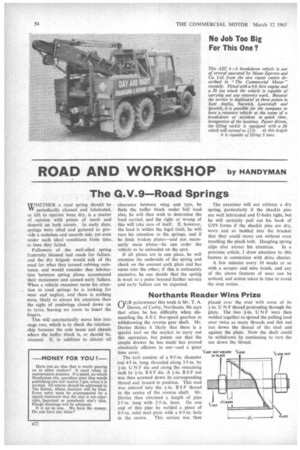ROAD AND WORKSHOP by HANDYMAN
Page 56

If you've noticed an error in this article please click here to report it so we can fix it.
The G.V.9—Road Springs
WHETHER a road spring should be VI' periodically cleaned and lubricated, or left to operate bone dry, is a matter of opinion with points of merit and demerit on both counts. In early days, springs were oiled and gaitered to provide a noiseless and smooth ride, yet even under such ideal conditions from time to time they failed.
Followers of the well-oiled spring fraternity blamed bad roads for failure, and the dry brigade would talk of the need for what they termed rubbing resistance, and would consider that lubrication between spring plates accentuated their movement and caused early failure. When a vehicle examiner turns his attention to road springs he is looking for wear and neglect, and there is nothing more likely to attract his attention than the sight of mudwings closed down on to tyres, leaving no room to insert the fingers.
This will automatically move him into stage two, which is to check the relationship between the axle beam and chassis where the buffer block is, or should be, situated. If, in addition to almost nil clearance between wing and tyre, he finds the buffer block under full load also, he will then wish to determine the load carried, and the right or wrong of this will take care of itself. If, however, the load is within the legal limit, he will turn his attention to the springs, and if he finds broken plates—and not necessarily main plates—he can order the vehicle to he unloaded on the spot.
If all plates are in one piece, he will examine the underside of the spring and check on the amount each plate end has eaten into the other; if this is noticeably excessive, he can decide that the sprin-g is weak toa point beyond further service and early failure can be expected.
The examiner will not criticize a dry spring, particularly if the shackle pins are well lubricated and U-bolts tight, but he will certainly pull out his book of GV9 forms if the shackle pins are dry, worn and so bedded into the bracket that they could move out without even touching the pinch bolt. Dangling spring clips also attract his attention. In a previous article, I drew attention to this feature in connection with drive chatter.
A few minutes every 10 weeks or so with a scraper and wire brush, and any of the above features of wear can be noticed, and action taken in time to avoid the stop notice.
























































































































